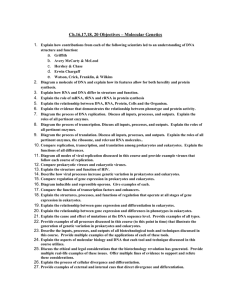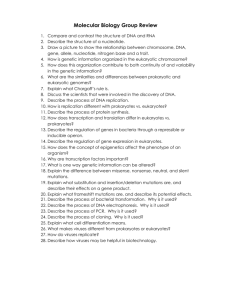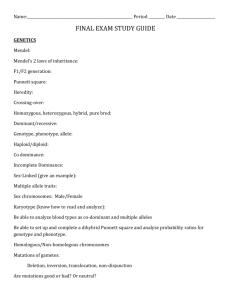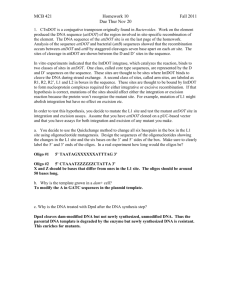AP Biology: Chapter 16 - 19
advertisement
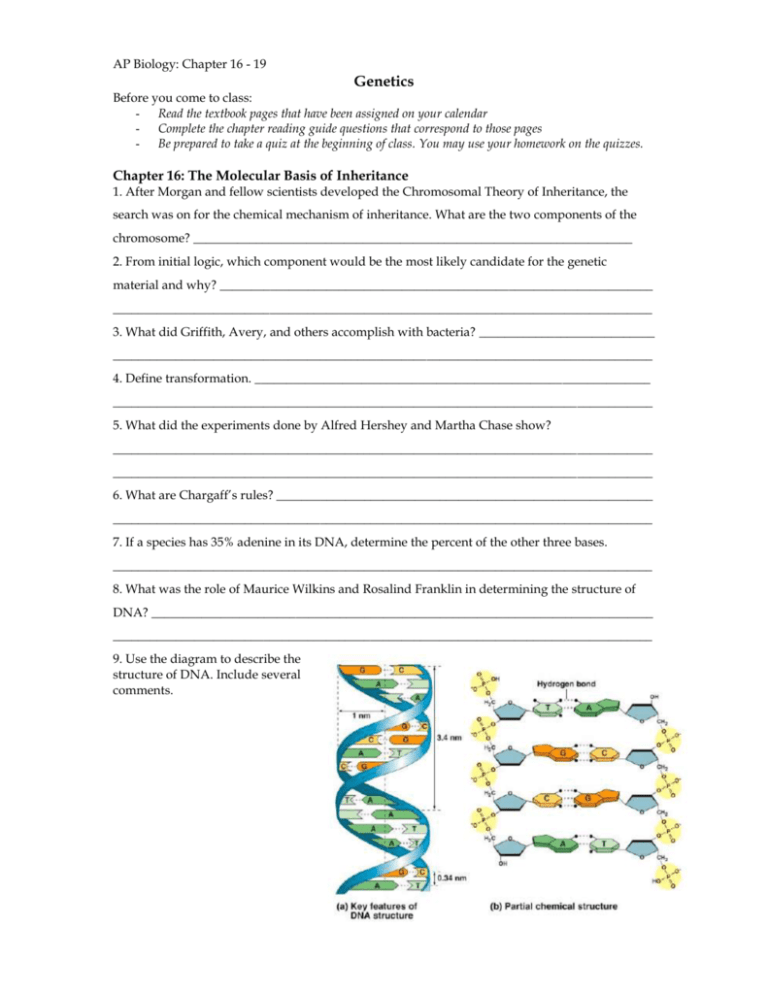
AP Biology: Chapter 16 - 19 Genetics Before you come to class: - Read the textbook pages that have been assigned on your calendar - Complete the chapter reading guide questions that correspond to those pages - Be prepared to take a quiz at the beginning of class. You may use your homework on the quizzes. Chapter 16: The Molecular Basis of Inheritance 1. After Morgan and fellow scientists developed the Chromosomal Theory of Inheritance, the search was on for the chemical mechanism of inheritance. What are the two components of the chromosome? ______________________________________________________________________ 2. From initial logic, which component would be the most likely candidate for the genetic material and why? _____________________________________________________________________ ______________________________________________________________________________________ 3. What did Griffith, Avery, and others accomplish with bacteria? ____________________________ ______________________________________________________________________________________ 4. Define transformation. _______________________________________________________________ ______________________________________________________________________________________ 5. What did the experiments done by Alfred Hershey and Martha Chase show? ______________________________________________________________________________________ ______________________________________________________________________________________ 6. What are Chargaff’s rules? ____________________________________________________________ ______________________________________________________________________________________ 7. If a species has 35% adenine in its DNA, determine the percent of the other three bases. ______________________________________________________________________________________ 8. What was the role of Maurice Wilkins and Rosalind Franklin in determining the structure of DNA? ________________________________________________________________________________ ______________________________________________________________________________________ 9. Use the diagram to describe the structure of DNA. Include several comments. 10. What is the advantage of the double stranded aspect of the DNA? ________________________ ______________________________________________________________________________________ ______________________________________________________________________________________ 11. Which model of DNA replication is accepted? __________________________________________ ______________________________________________________________________________________ 12. What happens at the DNA replication fork? ____________________________________________ ______________________________________________________________________________________ 13. Make a list of the enzymes involved in replication and their role. ______________________________________________________________________________________ ______________________________________________________________________________________ ______________________________________________________________________________________ 14. Why does the DNA have to add nucleotides in the 5’ to 3’ direction? ______________________________________________________________________________________ ______________________________________________________________________________________ 15. Label the diagram of DNA replication. Include the directions and the terms. 16. Describe the “priming of the DNA” before replication. __________________________________ ______________________________________________________________________________________ ______________________________________________________________________________________ 17. List some of the steps involved in DNA repair. _________________________________________ ______________________________________________________________________________________ ______________________________________________________________________________________ ______________________________________________________________________________________ 18. What is the problem that occurs at the ends of the chromosome during replication? ______________________________________________________________________________________ ______________________________________________________________________________________ ______________________________________________________________________________________ 19. What is a telomere and its role in cell division. __________________________________________ ______________________________________________________________________________________ ______________________________________________________________________________________ ______________________________________________________________________________________ 20. Why was there no selection pressure for prokaryotes to evolve a telomere-like solution on their chromosome? ____________________________________________________________________ ______________________________________________________________________________________ 21. Why is telomerase an active area in cancer research? ____________________________________ ______________________________________________________________________________________ ______________________________________________________________________________________ CHAPTER 17: FROM GENE TO PROTEIN 1. How did diseases involving metabolic pathways lead to hypotheses about the nature of genes? ______________________________________________________________________________________ ______________________________________________________________________________________ 2. Identify some genetic diseases that occur along metabolic pathways. ______________________________________________________________________________________ ______________________________________________________________________________________ 3. What was Beadle and Tatum’s hypothesis regarding enzymes? ______________________________________________________________________________________ ______________________________________________________________________________________ 4. How has that hypothesis been modified? _______________________________________________ ______________________________________________________________________________________ 5. What occurs during transcription? _____________________________________________________ ______________________________________________________________________________________ 6. What occurs during translation? _______________________________________________________ ______________________________________________________________________________________ 7. How does the protein process differ in prokaryotes and eukaryotes? ______________________________________________________________________________________ ______________________________________________________________________________________ 8. Briefly explain how Marshall Nirenberg and Heinrich Matthaei “cracked the genetic code?” ______________________________________________________________________________________ ______________________________________________________________________________________ 9. What is the genetic code and why is said to be universal? ______________________________________________________________________________________ ______________________________________________________________________________________ 10. List several features about the genetic code. ______________________________________________________________________________________ ______________________________________________________________________________________ 11. Give an example of what happens if reading frames are altered? ______________________________________________________________________________________ ______________________________________________________________________________________ 12. List the highlights of the three stages of transcription. a. Initiation ___________________________________________________________________________ ______________________________________________________________________________________ b. Elongation __________________________________________________________________________ ______________________________________________________________________________________ c. Termination _________________________________________________________________________ 13. What happens to the transcript RNA before it leaves the nucleus? ______________________________________________________________________________________ ______________________________________________________________________________________ 14. What is the advantage of the 5’ cap and poly A tail? ______________________________________________________________________________________ ______________________________________________________________________________________ 15. Distinguish between exons and introns. _______________________________________________ ______________________________________________________________________________________ 16. Describe the mechanism for splicing RNA. _____________________________________________ ______________________________________________________________________________________ 17. What does alternative RNA processing do for cells? ______________________________________________________________________________________ ______________________________________________________________________________________ 18. Identify the roles of the players of the translation process. a. Transfer RNA _______________________________________________________________________ ______________________________________________________________________________________ b. Aminoacyl-tRNA synthetase __________________________________________________________ ______________________________________________________________________________________ c. Ribosomes __________________________________________________________________________ 19. Identify and briefly describe the steps of translation. Initiation Elongation Termination ______________________________________________________________________________________ ______________________________________________________________________________________ 20. What is the advantage of polyribosomes? ______________________________________________ ______________________________________________________________________________________ 21. Give an example of how a polypeptide gets into the ER for additional processing. ______________________________________________________________________________________ ______________________________________________________________________________________ 22. How does protein synthesis differ between prokaryotes and eukaryotes? ______________________________________________________________________________________ ______________________________________________________________________________________ 23. Define point mutations. _____________________________________________________________ ______________________________________________________________________________________ 24. Define mutations that are: a. Missense ___________________________________________________________________________ ______________________________________________________________________________________ b. Nonsense ___________________________________________________________________________ ______________________________________________________________________________________ c. Insertion or deletion _________________________________________________________________ ______________________________________________________________________________________ 25. Use the diagram to trace the flow of chemical information from the gene to the protein product. CHAPTER 18: MICROBIAL MODELS 1. What makes microbes good models to study molecular mechanisms? ______________________________________________________________________________________ ______________________________________________________________________________________ 2. List several characteristics of viruses. ___________________________________________________ ______________________________________________________________________________________ 3. What are the two basic components of viruses? __________________________________________ ______________________________________________________________________________________ 4. Use the diagram to help explain typical viral reproduction. 5. Identify the cycle used by the virulent phage.___________________________________________________ _________________________________________________________ _________________________________________________________ 6. Compare the lytic and lysogenic cycles. 7. What is the role of the viral envelope? ___________________________________________________________ ___________________________________________________________ 8. Outline the steps in the life cycle of the envelope viruses. 9. Review the life cycle of the HIV virus. 10. What is reverse transcriptase and why is it important in biotechnology? ______________________________________________________________________________________ ______________________________________________________________________________________ 11. What is a vaccine? __________________________________________________________________ ______________________________________________________________________________________ 12. Where do emerging viruses come from? _______________________________________________ ______________________________________________________________________________________ 13. What is a viroid? Give some examples _________________________________________________ ______________________________________________________________________________________ 14. What is a prion and what do they do to the cells? _______________________________________ ______________________________________________________________________________________ 15. List and describe the three basic shapes of bacteria used for classification. ______________________________________________________________________________________ ______________________________________________________________________________________ 16. Most bacteria are not pathogenic. Identify several important roles they play in the ecosystem and human culture. ____________________________________________________________________ ______________________________________________________________________________________ 17. How do variations arise in bacteria considering they reproduce mostly by asexual means? ______________________________________________________________________________________ ______________________________________________________________________________________ 18. Define bacterial transformation. ______________________________________________________ ______________________________________________________________________________________ 19. How does transduction differ from transformation? ______________________________________________________________________________________ ______________________________________________________________________________________ 20. What is a plasmid and identify its role in bacterial conjugation? ______________________________________________________________________________________ ______________________________________________________________________________________ 21. What is the major method utilized by bacteria to pass along resistance to antibiotics? ______________________________________________________________________________________ ______________________________________________________________________________________ 22. What is a transposon? _______________________________________________________________ ______________________________________________________________________________________ ______________________________________________________________________________________ 23. Describe potential problems caused by transposons. ______________________________________________________________________________________ ______________________________________________________________________________________ ______________________________________________________________________________________ 24. E. coli use a regulatory system called an operon. Identify the components with their functions of the operon. ________________________________________________________________ ______________________________________________________________________________________ ______________________________________________________________________________________ 25. Use the diagram of the Tryp operon to outline how it regulated tryptophan levels. ______________________________________________________________________________________ ______________________________________________________________________________________ 26. Describe how the trp operon is a repressible operon. ______________________________________________________________________________________ ______________________________________________________________________________________ 27. Use the diagram of the lac operon to outline how it regulates glucose levels. ______________________________________________________________________________________ ______________________________________________________________________________________ 28. Does the diagram above represent the condition for the absence or presence of lactose? ______________________________________________________________________________________ ______________________________________________________________________________________ 29. Describe what happens when lactose is absent. _________________________________________ ______________________________________________________________________________________ 30. How is the lac operon an inducible system? ______________________________________________________________________________________ ______________________________________________________________________________________ 31. Summarize how the presence and absence of glucose influences the lac operon. ______________________________________________________________________________________ ______________________________________________________________________________________ CHAPTER 19: CONTROL OF EUKARYOTIC GENOME 1. Outline the levels of DNA packing within the eukaryote nucleus. 2. What is the difference between heterochromatin and euchromatin? Which is transcribed? ______________________________________________________________________________________ ______________________________________________________________________________________ 3. Which regions of the chromosome will typically be in the form of hererochromatin? ______________________________________________________________________________________ ______________________________________________________________________________________ 4. How do the coding regions and genome sizes of prokaryotes and eukaryotes compare? ______________________________________________________________________________________ ______________________________________________________________________________________ 5. Much of mammalian non-coding DNA is in the form of __________________________________ 6. What is the cause of Fragile X? ________________________________________________________ ______________________________________________________________________________________ 7. What is the cause of Huntington’s disease? ______________________________________________ ______________________________________________________________________________________ 8. Discuss an example of interspersed repetitive DNA? _____________________________________ ______________________________________________________________________________________ 9. What is a multigene family? ___________________________________________________________ ______________________________________________________________________________________ 10. Multigene families are hypothesized to have evolved from... _____________________________ ______________________________________________________________________________________ 11. How is the globulin multigene family an adaptive to mammals? ______________________________________________________________________________________ ______________________________________________________________________________________ 12. Explain how gene amplification can regulate gene expression. ______________________________________________________________________________________ ______________________________________________________________________________________ 13. How can transposons alter gene expression? ___________________________________________ ______________________________________________________________________________________ 14. How do immunoglobulin genes code for a seemingly infinite variety of antibodies? ______________________________________________________________________________________ ______________________________________________________________________________________ 16. Where is the most important step in gene regulation? ______________________________________________________________________________________ ______________________________________________________________________________________ 17. Describe the effect of each of the following control mechanisms. a. DNA methylation ___________________________________________________________________ b. Histone acetylation __________________________________________________________________ c. Transcription factors _________________________________________________________________ d. Control elements ____________________________________________________________________ e. Enhancers __________________________________________________________________________ f. Activators ___________________________________________________________________________ g. DNA-binding domain ________________________________________________________________ 18. How does alternative RNA splicing affect gene expression? ______________________________________________________________________________________ ______________________________________________________________________________________ 19. How does RNA degradation affect gene expression? ______________________________________________________________________________________ ______________________________________________________________________________________ ______________________________________________________________________________________ 20. How does protein processing and degradation affect gene expression? ______________________________________________________________________________________ ______________________________________________________________________________________ ______________________________________________________________________________________ _____________________________________________ 21. Identify the opportunities to regulate gene expression in eukaryotes. 22. Typically, what happens to cell function when cells become cancerous? ______________________________________________________________________________________ ______________________________________________________________________________________ ______________________________________________________________________________________ 23. What is a proto-oncogene? What happens to them when cancer occurs? ______________________________________________________________________________________ ______________________________________________________________________________________ ______________________________________________________________________________________ 24. List the three events that can turn proto-oncogenes into oncogenes. ______________________________________________________________________________________ ______________________________________________________________________________________ ______________________________________________________________________________________ 25. Identify and describe mutations in specific proteins that can lead to cancer. ______________________________________________________________________________________ ______________________________________________________________________________________ ______________________________________________________________________________________ 26. What is p53? _______________________________________________________________________ ______________________________________________________________________________________ ______________________________________________________________________________________ 27. Why is it said that cancer formation is a multi-step process? ______________________________________________________________________________________ ______________________________________________________________________________________ ______________________________________________________________________________________


